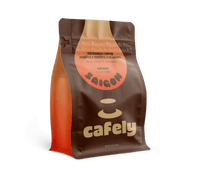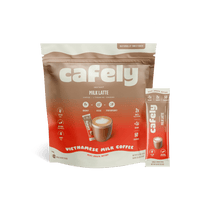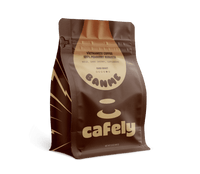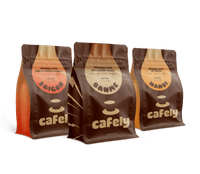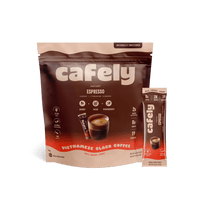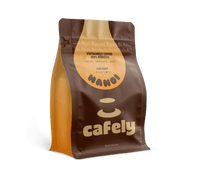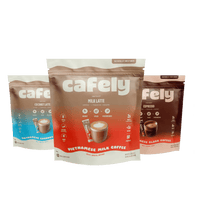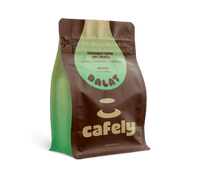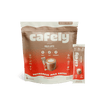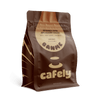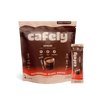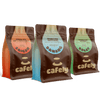The Espro Press is an immersion coffee brewer with dual microfilters in a basket-like construction.
Making coffee with the Espro Press is similar to making coffee with a traditional French press (Cafetière). Ground coffee is added to the brewer with hot water. The mixture is left to brew before “plunging” the filter through the coffee to separate the grounds.
Read on to learn how to make the perfect coffee using the Espro Press in this in-depth brew guide…
Brewing Specs: The Espro Press
- Brew Time: 4–7 minutes
- Coffee/Water Ratio: 1:12
- Grind: Coarse grind
- Water Temperature: 208ºF (98ºC)
- Recommended Coffee: Cafely DaLat, Saigon OG

Brewing Summary: Espro Press
- Grind the coffee to a coarse consistency similar to kosher salt.
- Add the coffee to the Espro Press.
- Fill the press with hot water.
- Wait four to seven minutes for the coffee to brew.
- Slowly push the plunger through the coffee to strain.
- Pour and enjoy the coffee black or with a dash of milk.
What You Need to Make Coffee With the Espro Press
To brew coffee with an Espro Press, you’ll need a few simple tools and ingredients.
Here’s what you’ll need to brew coffee with the Espro Press:
Tools
- Espro Press — The Espro Press is available in several sizes — 12 oz, 16 oz, 18 oz, and 32 oz. The smallest size makes two small cups of coffee, and the biggest makes four large cups.
- Kettle or Pan — You'll need hot water to brew coffee with an Espro Press. To achieve this, use a kettle or stovetop pan.
- Coffee Grinder — Freshly ground coffee makes the best brew. You'll need a coffee grinder capable of producing a coarse grind. Burr grinders offer the best grind consistency, but blade grinders also work.
- Coffee Measure — You’ll need a coffee measure or scale to produce perfect Espro Press coffee consistently.
- Coffee Mug — Your favorite coffee mug is ideal for serving press coffee.
Ingredients
- High-Quality Coffee — Opt for freshly roasted, high-quality coffee for the Espro Press.
- Water — Use fresh, clean, filtered water for brewing coffee in the Espro Press.
- Milk (Optional) — Add a dash of milk after brewing if you enjoy a creamier coffee.
Coffee Recommendations
You can use any type of coffee in the Espro Press. The type you select will alter the taste of the resulting cup.
Most people prefer to opt for a dark roast arabica coffee for press coffee. The naturally sweet, smooth flavors of arabica work particularly well when brewed with the Espro Press. We recommend Cafely DaLat for a rich, arabica press coffee.
Robusta beans produce a much darker, more bitter cup of coffee with a strong caffeine hit. If you’re looking for the ultimate pick-me-up, try our HaNoi Coffee (100% Robusta).
If you prefer a balance of dark and bitter, smooth and sweet, opt for a balanced blend of robusta and arabica. We recommend Saigon OG (Robusta x Arabica x Peaberry) for a balanced cup of Espro Press coffee.
How to Make Coffee With The Espro Press: Step-by-Step
Making coffee with the Espro Press is simple. If you’ve ever made coffee using a French press, you’ll know how this brewing method works — the only difference is in the brewing equipment.
Here’s how to make Espro Press coffee in six steps:
1. Measure & Grind the Coffee
First, measure your coffee. The amount you’ll need depends on how much coffee you want to brew.
Use this guide to work out how much coffee you need:
- 1 Cup — 9 grams
- 2 Cups — 18 grams
- 4 Cups — 36 grams
- 6 Cups — 54 grams
Once you’ve weighed your coffee beans, grind them coarse — a consistency similar to sea salt or kosher salt.
2. Boil the Water
Boil fresh, filtered water in a kettle or stovetop pan. Allow it to cool slightly before using it to brew the coffee. This will prevent over-extraction and scorching.
3. Add the Coffee Grounds & Water
Add the coffee grounds to the bottom of the Espro Press. Pour in the required amount of water and place the plunger and lid on top to retain heat inside the press. Do not plunge the filter through the coffee yet.
4. Wait for the Coffee to Brew
Set a timer for four to seven minutes and wait for the water to extract the flavors, oils, and aromas from the ground coffee. The longer you leave the Espro Press, the stronger the coffee will be.
5. Plunge & Pour the Coffee
Once the time is up, slowly push the plunger down through the coffee to separate the grounds.
Gently pour the brew into your favorite coffee mug and enjoy — if you want to drink it black.
6. Add Milk (Optional)
If you want a creamy Espro Press coffee, add a small amount of milk or cream and stir to combine.
Expert Tips & Tricks: Espro Press Brewer

Using an Espro Press is one of the easiest ways to make great-tasting coffee. However, a few extra steps will ensure your coffee is 10/10 every time.
Follow these tips and tricks To make sure your morning brew “wows you” day-in-day-out:
1. Preheat the Press
Although the stainless steel construction of the Espro Press retains heat better than a traditional French press coffee maker, it’s a good idea to preheat it. Before adding the coffee to the press, pour in some freshly bodied water.
Swirl the water around and pour it out after 10 seconds or so. This will preheat the press, ensuring that the coffee is piping hot once it has finished extracting.
2. Monitor the Water Temperature
Avoid pouring freshly boiled water into the press after adding the coffee grounds. The ideal water temperature for making coffee with the Espro Press is 208ºF (98ºC). To achieve this temperature, let the water cool in the kettle or pan for a few minutes before pouring.
Using hot but not scorching water produces a more even extraction — ensuring no bitter flavors are extracted from the beans.
3. Remove the Foam Before Plunging
Before pushing the plunger of the Espro Press through the coffee, consider skimming the foam and floating grounds off the top of the liquid. This “scum” on top of the brew is the fats and proteins from the coffee beans — not a crema as produced by an espresso machine or moka pot.
Removing this foam before plunging produces a cleaner brew with a thinner body.
4. Periodic Extraction
During the four to seven minutes of brewing time, consider pushing the plunger through the coffee periodically. Doing this will create a richer, darker brew.
After two to three minutes, push the plunger halfway down the press. Once the brewing time is complete, then push the plunger to the bottom of the Espro Press.
5. Look After Your Espro Press
Make sure to look after your Espro Press. Clean the press after each use using boiled water and a soft sponge.
After each time you brew coffee using your press, disassemble the filter and clean thoroughly with a small amount of dish soap and hot water. This will remove all the oils left behind by the coffee.
Make sure to rinse all elements of the press thoroughly before storage and store the elements separately to avoid mold growth. Proper cleaning and maintenance keep your press in good health — ensuring it produces high-quality coffee every time you use it.
FAQs: The Espro Press
Want to learn more about the Espro Press and other coffee brewing methods?
Read the answers to the frequently asked questions below…
1. What is an Espro Press?

The Espro Press is a redesigned version of the traditional French press. Instead of a single mesh filter on the plunger like a French press, the Espro Press has two microfilters in a basket construction. This provides a cleaner cup of coffee, free of sediment.
2. What Grind Size Should I Use for the Espro Press?
Like the traditional French press, you should use a coarse grind for the Espro Press. This ensures no sediment passes through the microfilters.
3. Is the Espro Press the Same as a French Press?
The Espro Press is similar to the French press. It works by immersing coarse-ground coffee in hot water before plunging. However, the Espro press uses a unique microfiltration system to create a cleaner, thinner brew with less sediment.
4. Can You Make Iced Coffee With an Espro Press?
Yes. You can make iced coffee with the Espro Press. Simply increase the coffee-to-water ratio and brew as normal to create a concentrated shot of coffee. Then, cool the shot, pour it over ice, and add milk to create a rich, clean, iced coffee.
5. Can You Make Cold Brew With an Espro Press?
Yes. You can use the Espro Press to make cold-brew coffee. Simply add ground coffee and cold water. Store the press in the refrigerator for 18 to 24 hours, then strain and enjoy.
6. How Much Caffeine in Press Coffee?
There are around 80–135 mg of caffeine in a 240 mL (8 oz.) cup of Espro press or French press coffee. However, this figure can vary depending on the brewing time, coffee-to-water ratio, and type of coffee beans used.
7. What is Moka Pot Coffee?
Moka pot coffee is a brew made using a moka pot brewing device. The moka pot is a small stovetop brewer that works by pushing boiling water through a filter basket filled with finely ground coffee. Moka pot coffee is strong, concentrated, and has a crema — similar to espresso.
8. What’s the Difference Between Drip and Pour-Over Coffee?
Drip and pour-over coffee are incredibly similar. The only difference is the way they’re prepared. Drip coffee is made using a drip coffee maker — a machine that automatically heats water and pours it over ground coffee. Pour-over coffee works by manually pouring hot water over ground coffee.
9. What’s the Difference Between Arabica and Robusta Coffee?
Arabica and robusta are two different types of coffee. Arabica coffee is naturally sweet, smooth, and mildly caffeinated. Robusta is dark, rich, bitter, and heavily caffeinated. Arabica is more popular in the West, and Robusta is more popular in the East.
10. What is a Phin Filter?
A phin filter is a traditional Vietnamese coffee brewing device. It’s a drip coffee filter that works by pouring hot water over ground coffee in a filter basket.
